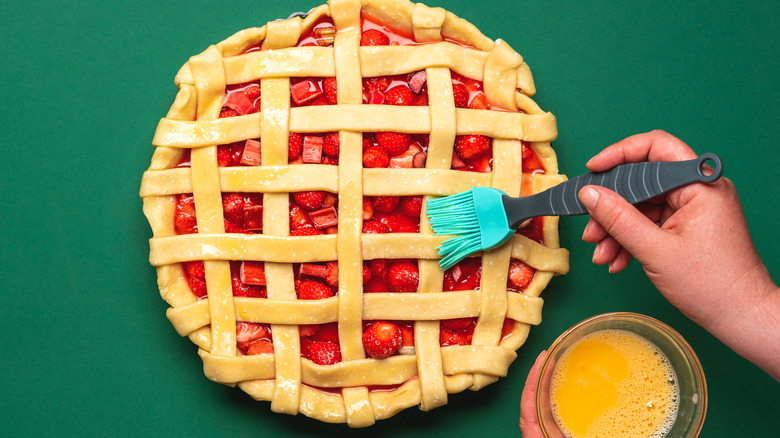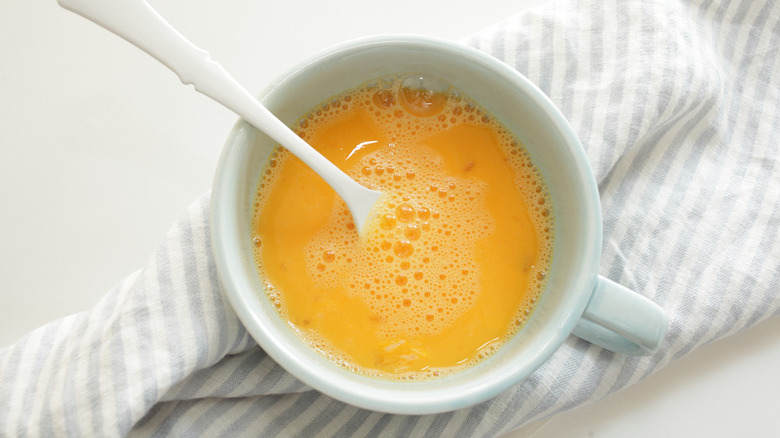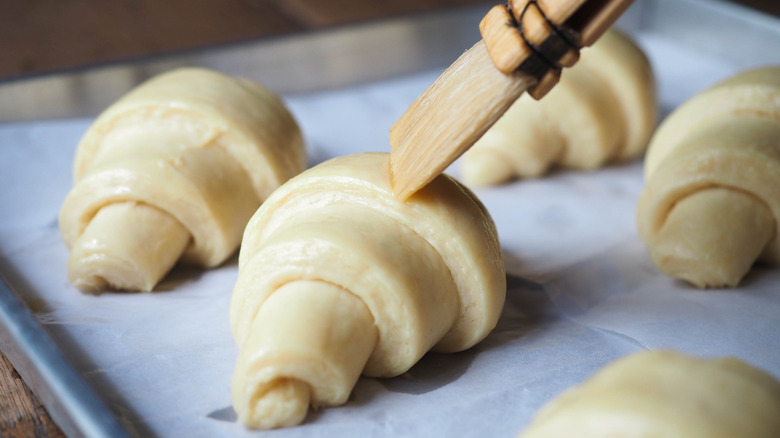How To Adjust An Egg Wash For Your Ideal Crust Color
Many baked goods call for an egg wash before entering the oven, but this step isn't a one-size-fits-all technique. Understanding the science behind the final stage allows bakers to manipulate the results to achieve the desired crust color.
For some recipes, the egg wash serves as a glue to adhere sprinkles, seeds, or sugar to the exterior. In others, it's used to achieve the Maillard reaction, adding flavor, texture, and a golden hue to the crust. Depending on the recipe, an egg wash may contain water, milk, heavy cream, or just egg, with each ingredient resulting in a different finish and texture.
By altering the egg wash recipe, you can control how deeply golden and crispy the exterior will become. Skipping this step can leave bakes looking bland and disappointing, lacking the desired flakiness and sheen. While there's no rule dictating that you must follow a specific recipe, a ratio of three parts egg to one part water is an excellent place to start. From there, you can adjust the amount and type of liquid to achieve the results you want.
Different egg wash techniques
For many bread and pastry recipes, using one tablespoon of water for every egg creates a golden exterior with a shiny finish. Replacing water with dairy, such as milk or cream, produces a lighter crust with a softer texture. Since water inhibits the Maillard reaction, increasing the liquid will lighten the crust.
To add shine but not color, use only egg whites and water. This approach is useful when making sugar cookies, allowing decorations like sanding sugar to adhere to the cookie's top without altering the dough's color. Eliminating the liquid altogether, on the other hand, will produce the deepest, darkest exterior. An easy cheddar scone recipe, for example, might use the entire egg to create a dark, golden brown top. For even darker results, save the egg white and only brush on a beaten egg yolk.
If you've used your last egg in the recipe, fear not; your pantry likely holds some egg substitutions to achieve the ideal crust color. Since mayonnaise contains egg, brushing on a thin layer can give the bake a glossy exterior without negatively impacting the flavor. Another option is using the cooking liquid from a can of beans, known as aquafaba, in place of an egg wash. Keep in mind that you can control the sodium content better by using unsalted beans. Aquafaba has many culinary applications, particularly in vegan cuisine, and when brushed on baked goods, it imparts a subtle gloss similar to that of using an egg white.
How to properly apply an egg wash
After you've invested so much effort in preparing the recipe, it would be a shame to damage the surface, so here are some things to remember when brushing on an egg wash.
Regardless of the egg-to-liquid ratio, use a fork to thoroughly whisk the egg until it's smooth so it glides across the surface easily. If you encounter stubborn globs of egg whites, add a pinch of salt to the bowl, which will promote the protein to coagulate, and continue whisking until foamy. Then, use a natural bristle or silicone pastry brush to gently apply the coating, especially when working with delicate recipes like croissants that can tear easily. Although it's debatable which brush provides better results, silicone tends to be easier to clean.
It's best to brush on a thin layer of egg wash rather than lacquering it on, as applying it too thickly can cause the crust to burn. If you find that the crust hasn't developed enough color, you can apply a second thin layer of egg wash ten minutes before the recipe is finished baking to darken it. For bakes that are folded or braided like challah, make sure to prevent the egg wash from pooling in crevices, as this can lead to uneven coloring. Egg wash can be stored in the refrigerator for several days, or you can use it in scrambles, so don't let extras go to waste.



